TRANSITION ELEMENTS
· A transition element is defined as one which has an incompletely filled d orbital in its ground state or in any one of its oxidation states.
· Zinc, cadmium, and mercury are not regarded as transition metals due to completely filled d-orbital.
Position of transition elements in the Periodic Table
Thed–block occupies the large middle section of the periodic table flanked betweens– andp– blocks in the periodic table. Thed–orbital of the penultimate energy level of atoms receive electrons giving rise to four rows of the transition metals, i.e., 3d, 4d, 5dand 6d.
Electronic Configurations of the d-Block Elements
In general the electronic configuration of outer orbital’s of these elements is (n-1)d1–10ns1–2. The (n–1) stands for the innerdorbital’s which may have one to ten electrons and the outermost nsorbital may have one or two electrons. However, this generalisation has several exceptions because of very little energy difference between (n-1)dand nsorbital’s. Furthermore, half and completely filled sets of orbital’s are relatively more stable. A consequence of this factor is reflected in the electronic configurations of Cr and Cu in the 3dseries. For example, consider the case of Cr, which has 3d54s1configuration instead of 3d44s2; the energy gap between the two sets (3dand 4s) of orbital’s is small enough to prevent electron entering the 3dorbital’s. Similarly in case of Cu, the configuration is 3d104s1and not 3d94s2.

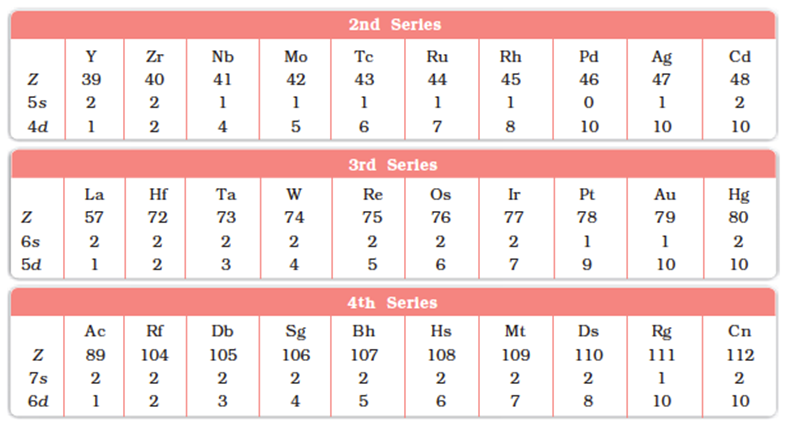
The electronic configurations of outer orbitals of Zn, Cd, Hg and Cn are represented by the general formula (n-1)d10ns2. The orbitals in these elements are completely filled in the ground state as well as in their common oxidation states. Therefore, they are not regarded as transition elements.
Thedorbitals of the transition elements protrude to the periphery of an atom more than the other orbitals (i.e.,sandp), hence, they are more influenced by the surroundings as well as affect the atoms or molecules surrounding them. In some respects, ions of a givendnconfiguration(n = 1 – 9) have similar magnetic and electronic properties. With partly filledd orbitals these elements exhibit certain characteristic properties such as display of a variety of oxidation states, formation of coloured ions and entering into complex formation with a variety of ligands.
General Properties of the Transition Elements
Physical Properties of transition elements
Nearly all the transition elements display typical metallic properties such as high tensile strength, ductility, malleability, high thermal and electrical conductivity and metallic lustre. With the exceptions of Zn, Cd, Hg and Mn, they have one or more typical metallic structures at normal temperatures.
Transition metals are hard and have low volatility with high melting and boiling points. The high melting points are due to the involvement of greater numbers of electrons from (n-1)d in addition to ns electrons in interatomic metallic bonding. The enthalpies of atomization of transition metals are high, and metals with very high enthalpy of atomization tend to be noble in their reactions. Metals of the second and third series have greater enthalpies of atomization than corresponding elements of the first series, which accounts for the occurrence of much more frequent metal-metal bonding in compounds of the heavy transition metals.
Variation in Atomic and Ionic Sizes of Transition Metals
Due to the addition of new electron to ad-orbital each time the effective nuclear charge increases which causes the atomic radii to decrease in a series of transition elements. However, the atomic size of Fe, Co, Ni is almost the same because the attraction due to increase in nuclear charge is cancelled by the repulsion because of increased in shielding effect. The size of the 4dseries elements is almost the same as the size of the 5dseries elements. This phenomenon is associated with the intervention of the 4forbitals which must be filled before the filling starts in 5dsubshell.
Lanthanoid contraction
The filling of the 4fbefore the 5dorbital results in a regular decrease in size called lanthanoid contraction. This compensates for the expected increase in the atomic size with increasing atomic number. The net result of the lanthanoid contraction is is that the 4dand 5dseries elements exhibit similar radii and show similarity in their physical and chemical properties.
Ionisation Enthalpies of transition elements
In a particular transition series, there is an increase in ionization enthalpy from left to right which is due to the increase in effective nuclear charge along a series. But the trend is not very regular. The exceptions are chromium and copper which have notably larger ionization enthalpy than their neighbours. These exceptions are due to the extra stability associated with the half-filled and fully-filled set ofd-orbitals.
Oxidation States of transition elements
Transition metals show variable oxidation states due to tendency of (n-1)das well asnselectrons to take part in bond formation.
For example:- Oxidation states of the first row transition metals are:
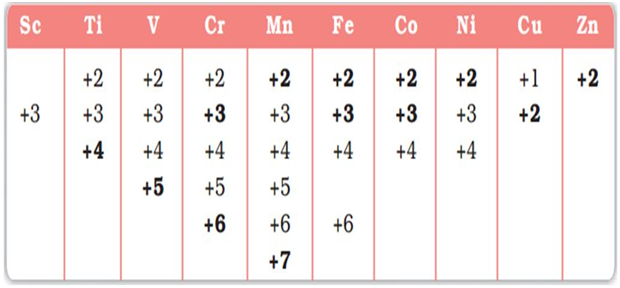
Trends in the M2+/M Standard Electrode Potentials
- · There is no regular trend in the E0(Mn2+/M) values. This is because their ionization enthalpies (I1 + IE2) and sublimation enthalpies do not show any regular trend.
- · The general trend towards less negative E0values along the series is due to the general increase in the sum of first and second ionization enthalpies.
- · Copper shows a unique behaviour in the series as it is the only metal having positive value for E0. This explains why is does not liberate H2 gas from acids. It reacts only with the oxidizing acids (HNO3and H2SO4) which are reduced. The reason for positive E0value for copper is that the sum of enthalpies of sublimation and ionization is not balanced by hydration enthalpy.
- · The values of E0for Mn, Ni and Zn are more negative than expected from the general trend. This is due to greater stability of half-filled d-subshell (d5) in Mn2+, and completely filled d-subshell (d10) in Zn2+. The exceptional behaviour of Ni towards E0value from the regular trend is due to its high negative enthalpy of hydration.
Trends in the M3+/M2+ Standard Electrode Potentials
1. A very low value for E0(Sc3+/Sc2+) reflects the stability of Sc3+ ion which has a noble gas configuration.
2. The highest value for Zn is on account of very high stability of Zn2+ion with d10configuration. It is difficult to remove an electron from it to change it into +3 states.
3. The comparatively high value of E0(Mn3+/Mn2+) shows that Mn2+is very stable which is on account of stable dsconfiguration of Mn2+.
4. The comparatively low value of E0(Fe3+/Fe2+) is on account of extra stability of Fe3+(ds), i.e., low third ionization enthalpy of Fe.
5. The comparatively low value for V is on account of the stability of V2+ion due to its half-filled t32gconfiguration.
Trends in Stability of Higher Oxidation States
Standard electrode potential data provide valuable information about the stabilities of different oxidation states shown by an element. The highest oxidation states are shown generally among halides and oxides.
1) In metal halides
The transition elements react with halogens at high temperatures to form transition metal halides. These reactions have very high activation energies, therefore, higher temperatures are required to start the reaction. But once the reaction starts, the heat of reaction is sufficient to continue the reaction.
The halogens react in the order:
Order of reactivity: F2> Cl2> Br2> I2
|
Element |
Oxidation Number |
Compounds |
|
Sc |
+6 |
ScX3 |
|
Ti |
+4 , +3 , +2 |
TiX4, TiX3, TiX2 |
|
V |
+2 , +3 , +4 , +5 |
VX2, VX3, VX4, VX5 |
|
Cr |
+2 , +3 , +4 , +5 ,+6 |
CrF6, CrF5, CrX4, CrX3, CrX2 |
|
Mn |
+2 , +3 , +4 |
MnX2, MnF3, MnF4 |
|
Fe |
+3 , +2 |
FeX3, FeX2 |
|
co |
+2 , +3 |
CoF3, CoX2 |
|
Ni |
+2 |
NiX2 |
|
Cu |
+1 , +2 |
CuX2, CuX |
|
Zn |
+2 |
ZnX2 |
The second and third transition series elements exhibit higher coordination numbers and their higher Oxidation states are more stable than the corresponding first transition series elements.
a) The elements of first transition series trend to exist in low oxidation states. Chromium to zinc form stable difluorides and the other chlorides are also known.
b) Since fluorine is the most electronegative element, the transition metals show highest oxidation states with fluorine.For example : CrF6and VF5
c) The highest oxidation states are found in TiX4(tetrahalides, X =F , cl , Br and I) , VF5and CrF6
d) The +7 oxidation state for Mn is not shown by simple halides. However MnO3F is known in which the oxidation state of Mn is +7.
e) After Mn, the tendency to show higher oxidation states with halogens are uncommon. Iron and cobalt form trihalides FeX3(X = F, Cl or Br) and CoF3
f) The tendency of fluorine to stablise the highest oxidation state is due to either higher lattice enthalpy as in case of CoF3or higher bond enthalpy due to higher covalent bonds e.g. VF5and CrF6
g) V(V) is shown by VF5only. However, the other halides undergo hydrolysis to form oxohalides, VOX3
h) Fluorides are relatively unstable in their low oxidation states.
For example:Vanadium forms only VX2(X = Cl, Br or I ) and copper can form CuX (X = CI, I). All copper (II) halides are known except the iodide. This is because, Cu2+ oxidises I–to I2.
2 Cu2++4I–→ Cu2I2(s) + I2
Many copper (I) compounds are unstable in aqueous solution and they undergo disproportionation to Cu(ll) and Cu (0) as:
2Cu+→ Cu2++ Cu
Copper in +2 oxidation state is more stable than in +1 oxidation stateThis can be explained on the basis of much larger negative hydration enthalpy (ΔhydHφ) of Cu2+(aq) than Cu+, which is much more than compensatesfor the large energy required to remove the second electron i.e. So ionisation enthalpy of copper.
2) In metal oxides and oxo cations
The ability of oxygen to stabilize the highest oxidation state is remarkably exhibited in their oxides. The highest oxidation states in their oxides coincide with the group number.
For example :The highest oxidation state of scandium of group 3 is +3 in its oxide , Sc2O3
The highest oxidation state of manganese of group 7 is +7, in Mn2O7. However beyond group 7, no higher oxides of iron above Fe2O3are known.
Though higher oxidation state such as +6 is shown in ferrates such as Fe3O42-in akaline medium, but they readily decompose to Fe2O3and O2.Oxocations of the metals also stabilise higher oxidation states.
For example:V(IV) as VO2+, V(VI) as V and T(III) as TiO2+. The ability of oxygen to stabilise these high oxidation states exceeds that of fluorine.
For example :Manganese forms highest fluoride as MnF4, whereas the highest oxide is Mn2O7. This is due to the tendency of oxygen to form multiple bonds. In the covalent oxide, Mn2O7, each Mn is tetrahedrally surrounded by oxygen atoms and has Mn-O-Mn bridge. The tetrahedral [MO4]n- ions are also known for vanadium, (V) chromium (VI), manganese (VI) and manganese (VII).
Magnetic Properties of transition elements
The magnetic properties of a compound are a measure of the number of unpaired electrons in it. When a magnetic field is applied, there are two main types of substances:
(a) Paramagnetic substances:The substances which are attracted by magnetic field are called paramagnetic substances and this character arises due to the presence of unpaired electrons in the atomic orbitals.
(b) Diamagnetic substances :The substances which are repelled by magnetic filed are called diamagnetic substances and this character arises due to the presence of paired electrons in the atomic orbitals.
Explanation for paramagnetic character of transition elements
The transition elements involve the partial filling of d-subshells. Most of the transition metal ions or their compounds have unpaired electrons in d-subshell (from configuration d1to d9) and therefore, they give rise to paramagnetic character.
The magnetic character is expressed in terms of magnetic moment. The larger the number of unpaired electrons in a substance, the greater is the paramagnetic character and larger is the magnetic moment. The magnetic moment is expressed in Bohr magnetons abbreviated as B.M.
Paramagnetism arises from the presence of unpaired electrons. Each unpaired electron have magnetic moment associated with its spin angular momentum and orbital angular momentum. Therefore, for the first transition series elements, the magnetic moments arise only from the spin of the electrons.
This can be calculated from

where n is the number of unpaired electrons andμis magnetic moment in Bohr magenton (BM) units. BM represents Bohr magneton. As the number of unpaired electrons increases from 1 to 5, the magnetic moment and hence the paramagnetic character also increases. After d5configuration, there is decrease in magnetic moment due to decrease in number of unpaired electrons.For example: d6configuration has 4 unpaired electrons, d7 configuration has 3 unpaired electrons and so on.
Formation of Coloured Ions of transition elements
Transition metals and their compounds show colour. The colour is due to the excitation of electron from onedatomic orbital to higher energydatomic orbital in the same subshell. The frequency of the light absorbed generally lies in the visible region. The colour observed is due to the colour of the complementary light. The colour is due to the presence of unpaired electrons. All Zn2+ compounds are white.
Formation of Complex Compounds of transition elements
The transition metals form a large number of complexes. This is due to their
o Comparatively small sizes of the metal ions.
o High ionic charges.
o Availability of vacant d atomic orbitals
Catalytic Properties of transition elements
Most of the transition metals are used as catalysts.
This is due to the
(i) presence of incomplete or emptyd-orbitals,
(ii) large surface area and
(iii) variable oxidation state. For example Fe, Ni, V2O3, Pt, Mo, Co, etc., are used as catalyst.
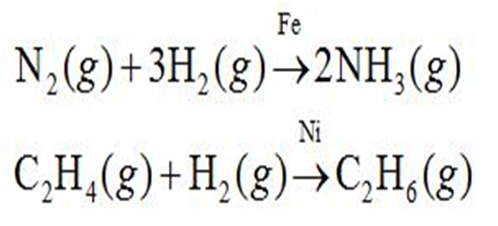
Formation of Interstitial Compounds of transition elements
Transition metals have lattice structure in which the unoccupied space is called void or hole or interstices. Transition metals entrap smaller but highly electronegative elements in these interstices and results in the formation of interstitial compounds. Interstitial com-pounds have high melting points, hardness and retain metallic conductivity. The interstitial compounds are chemically inert. Examples are TiC, steel.
Alloy Formation of transition elements
Alloy is a homogeneous mixture of two or more metals. Due to the comparable size of transition metals, one metal can displace other metal in the crystal lattice and this results in the alloy formation. The alloys so formed are hard and have high melting points. The best known are ferrous alloys; chromium, vanadium, tungsten, manganese are used for the production of variety of steels and stainless steels.
Formation of oxides
Transition metals form oxides on reaction with oxygen at elevated temperature. Transition metal form oxide in oxidation state of + 1 (in Ag2O) to + 7 (Mn2O7) to + 8 (in OsO4). As the oxidation number increases in case of same elements,
(a) The covalent character of oxides increases.
(b) The acidic strength of the oxides increases.
(c) The oxidizing power of oxides increases.
For example, Cr2O3is amphoteric while CrO is basic and CrO3 is acidic.
Some Important Compounds of Transition Elements
Potassium dichromate
Preparation:
It is prepared by fusion of chromate ore (FeCr2O4) with sodium carbonate in excess of air.
8Na2CO3+ 4FeCr2O4+ 7O2→ 8Na2CrO4+ 2Fe2O3+ 8CO2
Yellow
Na2CrO4produced in the above reaction is then acidified to get sodium dichromate, Na2Cr2O7
Na2CrO4produced in the above reaction is then acidified to get sodium dichromate, Na2Cr2O7
2Na2CrO4+ H2SO4→ Na2Cr2O7+ Na2SO4+ H2O
Orange
Solution of sodium dichromate treated with potassium chloride to get the final product, K2Cr2O7.
Na2Cr2O7 + 2KCl → K2Cr2O7 + 2NaCl
Orange Crystals
Structures of CrO42‒and Cr2O72‒ions:
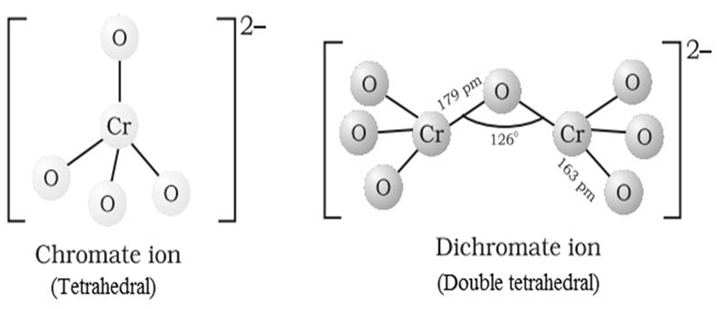
Uses:
Potassium dichromate is used as a primary standard in volumetric analysis and as an oxidizing agent. In acidic medium, the oxidation state of Cr changes from + 6 in Cr2O72‒to + 3 in Cr3+.
Cr2O72‒+ 14 H++ 6e‒→ 2Cr3++ 7H2O
Potassium permanganate
Preparation:
It is prepared by the fusion of MnO4 with alkali metal hydroxide (KOH) in the presence of O2or an oxidising agent like KNO3. It produces a dark green-coloured compound, K2MnO4 which undergoes oxidation as well as a reduction in a neutral or acidic solution to give permanganate.
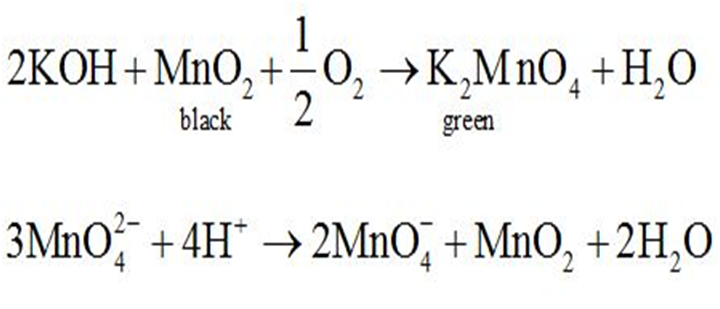
Commercially it is prepared by the alkaline oxidative fusion of MnO2 followed by the electrolytic oxidation of manganate (Vl).
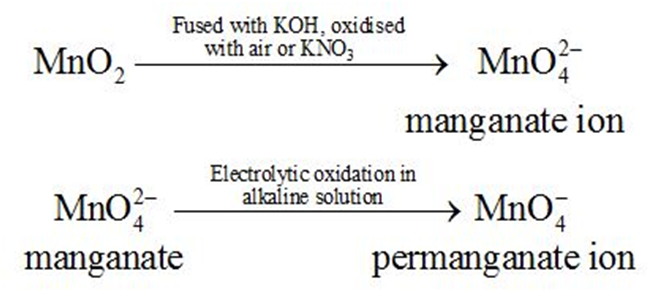
Uses:
Potassium permanganate acts as a strong oxidizing agent in acidic, neutral or faintly basic medium.
In acidic medium:
MnO4‒+ 8H++ 5e‒→ Mn2++ 4 H2O
Oxidises Fe2+to Fe3+:
Fe2+→ Fe3++ e─
In an alkaline medium:
MnO4‒+ 2H2O + 3e‒→ MnO2+ 4OH‒
Oxidises I−to iodate IO3‒:
6OH‒+ I‒→ IO3‒+ 6e‒+ 3H2O